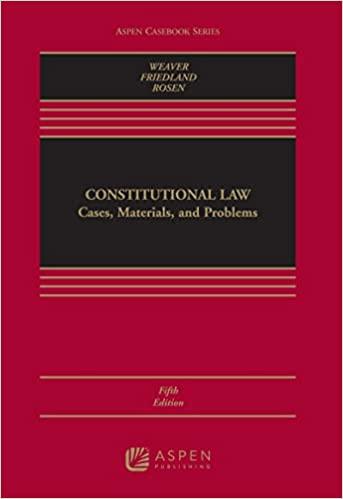Question
In Gibbons v. Ogden , as an encouragement to investment, New York state granted Robert Livingston and Robert Fulton the exclusive right to operate steamboats
In Gibbons v. Ogden, as an encouragement to investment, New York state granted Robert Livingston and Robert Fulton the exclusive right to operate steamboats in New York waters for a period of up to thirty yearsin other words, a monopoly. Livingston and Fulton in turn assigned (or transferred) to Aaron Ogden an exclusive license to operate steamboats between New York City and New Jersey. Ogden subsequently brought an action in New York state court to enjoin (that is, stop) Thomas Gibbons from operating a competing service between New York City and Elizabethtown, New Jersey. Gibbons responded that his boats were licensed by an act of Congress, which trumped New York's grant of monopoly. The New York courts held for Ogden, on the ground that Congress had not intended to grant a license in the sense Gibbons contended. Because this reading eliminated any conflict between federal and state law, the New York courts refused to decide whether Congress could override New York's grant of monopoly if it so chose or whether the federal law granting Gibbons's license fell within Congress's Article I
powers. The Supreme Court of the United States reversed.
In Gibbons v. Ogden 22 U.S. 1 (1824), What are the legally important facts?
What is the legal issue?
What question of institutional choice does this issue pose?
What legal rule does the court apply to resolve this question?
In cases of federalism, the rule of law is usually the Supreme Court's interpretation of the first power. In this case, the relevant power has several different elements, each of which the Court interprets. The result is a multi-part rule. In such cases, the application of each part of the rule usually creates a separate subquestion.
Is the law a rule?
Does it regulate commerce?
Although some of these issues may be very easy, there is no need for any substantive discussion.
What arguments does the Court offer to explain its conclusion?
How many different types of argument (text, precedent, practical considerations, institutional arguments)?
Are you persuaded by the Court's arguments? Why or why not?
Step by Step Solution
There are 3 Steps involved in it
Step: 1

Get Instant Access to Expert-Tailored Solutions
See step-by-step solutions with expert insights and AI powered tools for academic success
Step: 2

Step: 3

Ace Your Homework with AI
Get the answers you need in no time with our AI-driven, step-by-step assistance
Get Started


